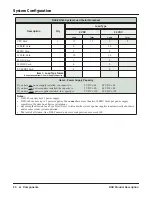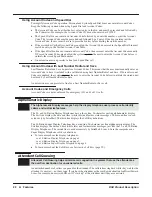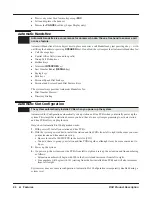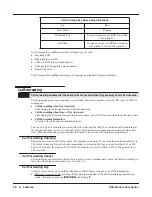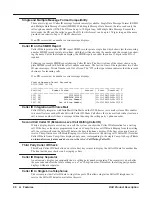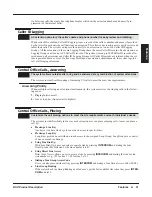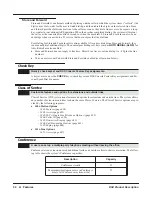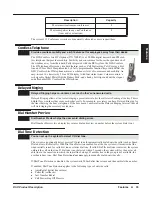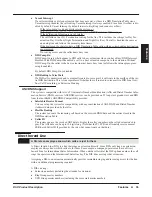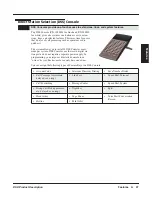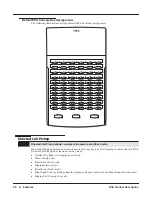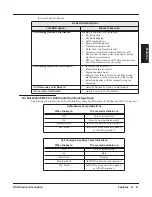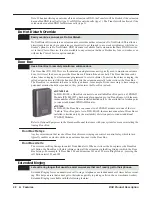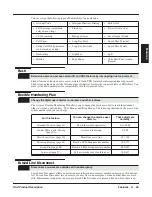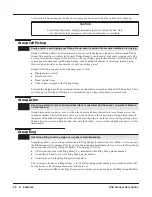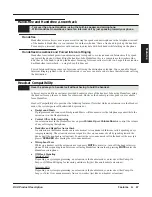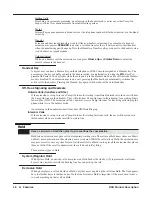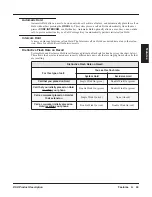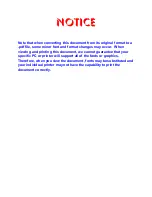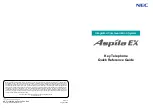
34
◆
Features
DSX Product Description
❥
Save
❥
Speed Dial
Direct Inward Dialing
Direct Inward Dialing (DID) lets outside callers directly dial system extensions. DID saves time for callers
who know the extension number they wish to reach. To place a DID call, the outside caller dials the local
exchange (NXX) and additional digits to ring the telephone system extension. For example, DID number
926-5400 can directly ring extension 400. The caller does not have to rely on an attendant or receptionist to
handle the call. Direct Inward Dialing is an ef
fi
cient way to handle incoming calls, since callers can reach a
large block of extensions over a relatively small number of DID lines. Direct Inward Dialing requires a T1
PCB and T1 DID service with a block (range) of DID numbers from the telco.
For outgoing calls, DID lines operate identically to loop start lines.
In addition to direct dialing of system extensions, DID provides:
❥
DID Dialed Number Translation
The system provides a 100-entry DID Translation Table. This table gives you more
fl
exibility when buy-
ing DID service from the telco. If you can't buy the exact block of numbers you need (e.g., 300-399), use
the translation table to convert the digits received. For example, a translation table could convert digits
500-599 to extension numbers 300-399.
By default, the system uses the last 2 digits of the received DID number to route to extensions 300-399.
❥
Flexible DID Service Compatibility
You can program the system to be compatible with DID service of varying lengths (up to 8 digits). DID
service is typically 3 or 4 digits long. With 4 digit service, the telco sends 4 digits to the system for trans-
lation. With 3 digit service, the telco sends 3 digits to the system for translation. Be sure to set up your
system for compatibility with the provided telco service. Additionally, the system is compatible with
Dial Pulse (DP) and DTMF DID signaling. DID lines can be either wink start or immediate start.
By default, there are no DID lines programmed.
❥
DID Station Intercept
DID Station Intercept automatically reroutes DID calls under certain conditions. There are 3 types of
DID Station Intercept:
- Busy/DND Intercept
If a caller dials an extension that is busy or in Do Not Disturb, the system routes the call to the
extension’s programmed DID Station Intercept destination.
- Ring No Answer Intercept
If a caller dials an extension that is unanswered, the system routes the call to the extension’s pro-
grammed DID Station Intercept destination.
- Busy/DND and Ring No Answer Intercept
If a caller dials an extension that is busy, in Do Not Disturb, or is unanswered, the system routes the
call to the extension’s programmed DID Station Intercept destination.
By default, DID Station Intercept is disabled for all extensions.
❥
Line Over
fl
ow
If an incoming DID call is not answered at the destination extension or at the programmed intercept des-
tination, it routes according to Line Over
fl
ow. This ensures that the call has an answering point in the
system. Line Over
fl
ow typically routes to voice mail or to an extension. If the call is not answered at the
over
fl
ow extension, it normally diverts to Key Ring. If Line Over
fl
ow is disabled, an unanswered DID
call routes to Key Ring (and cannot over
fl
ow).
By default, Line Over
fl
ow is disabled. Unanswered calls route to Key Ring (and cannot over
fl
ow).
Directly dial system extensions from outside the system.
Summary of Contents for DSX PRODUCT DESCRIPTION
Page 150: ...138 IntraMail Features DSX Product Description...
Page 160: ...Parts List 148 Specifications and Parts DSX Product Description...
Page 161: ......

